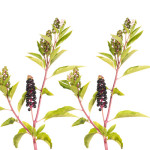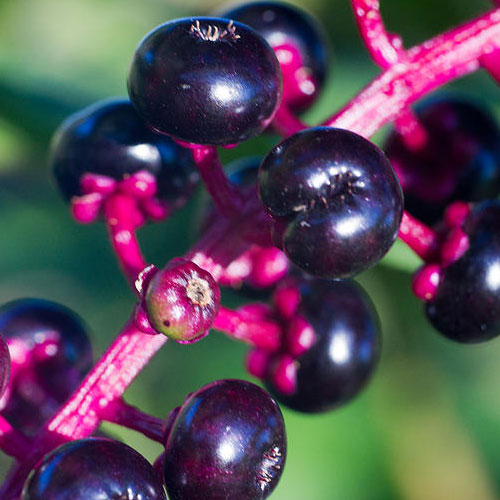American Pokeweed
“Hundreds of trees grow very tall and dance along with other trees. The activities of the trees are worth observing. Though many plants are dependent on water, few plants grow wonderfully in the water deficit zones of the earth like deserts. This topic will deal with American Pokeweed. The botanical name of this pokeweed is phytolacca Americana. These plants are cultivated lavishly in United States. These plants have high level of toxicity and poses risk to human being. These plants have bluish stems and white tap roots. The flowers are green to white. These plants are often found in pastures, recently cleared areas, and woodland openings. Pokeweed is a member of phytolaccaceae and a perennial plant. The birds disperse the seeds after eating the berries. They do not get affected by the toxicity of the seeds. The other common names of these plants are pokeberry, poke root, inkberry, pigeon berry.”
No slides are available in this gallery
Aspects

American Pokeweed
- Pokeweed (Phytolacca americana) is a perennial flowering plant found in gardens, pastures and along roadsides in North America. It is also known as pokeberry, poke, inkberry, or American nightshade. It is native to the eastern and midwestern United States, but has been introduced to other parts of the world.
- Pokeweed is a large plant, growing up to 8 feet tall, with large, elliptical leaves. The leaves are hairy and sometimes have purplish veins. The flowers are white to light green and are clustered in drooping, terminal racemes. The fruits are dark purple, round berries that contain a number of seeds.
- Pokeweed is an important food source for many birds, mammals, and insects, and is a larval host for some butterflies. The young leaves, stems, and roots are edible, but must be cooked to remove toxins. The fruits can be made into a dye, and the roots and leaves can be used as a soap.
- Pokeweed is potentially toxic. All parts of the plant contain an alkaloid called phytolaccin, which can cause nausea, vomiting, abdominal pain, and diarrhea if ingested. Ingesting the raw fruits can cause severe illness, especially in children. Even though the cooked leaves and stems are edible, they should not be eaten in large quantities as they can cause gastric disturbances.
- Pokeweed is also an invasive species in some areas and can be difficult to control. Its aggressive growth habit and ability to spread quickly via underground rhizomes make it difficult to remove. It can also produce toxins that can inhibit the growth of other plants in the area.
- Although pokeweed can be a nuisance, it also has some beneficial uses. The leaves, stems, and roots can be used for food, and the berries can be used to make dye. It can also be a valuable source of food for wildlife, and the flowers attract a variety of butterflies.
- Pokeweed is an interesting and attractive plant, but it is important to take caution when dealing with it. It can be toxic if ingested, and it can be invasive if left unchecked. It is therefore important to be aware of the potential dangers associated with this plant, and to take the necessary precautions when dealing with it.
| Nutrients |
Amount Value |
% DV of RDA |
| Vitamins |
|
|
| Vitamin A |
14355IU |
287% |
| Vitamin B6 |
0.18315mg |
9% |
| Vitamin B12 |
0mcg |
0% |
| Vitamin B12, Added |
0mcg |
0% |
| Vitamin C |
135.3mg |
14% |
| Vitamin D |
0IU |
0% |
| Vitamin D2 |
~ |
|
| Vitamin D3 |
~ |
|
| Vitamin D (D2 + D3) |
0mcg |
0% |
| Vitamin E (Alpha-tocopherol) |
1.4025 mg |
7% |
| Vitamin E, Added |
0 mg |
0% |
| Vitamin K |
178.2 mcg |
223% |
| Thiamin |
0.1155 mg |
8% |
| Riboflavin |
0.4125 mg |
24% |
| Niacin |
1.815 mg |
9% |
| Pantothenic Acid |
0.06435 mg |
1% |
| Folate |
14.85 mcg |
4% |
| Folate, Food |
14.85 mcg |
4% |
| Folate, DFE |
14.85 mcg |
4% |
| Choline |
0.495 mg |
~ |
| Betaine |
0.33 mg |
~ |
|
|
| Minerals |
|
|
| Calcium |
87.45 mg |
9% |
| Iron |
1.98 mg |
11% |
| Magnesium |
23.1 mg |
6% |
| Phosphorus |
54.45 mg |
5% |
| Potassium |
303.6 mg |
6% |
| Sodium |
419.1 mg |
18% |
| Zinc |
0.3135 mg |
2% |
| Copper |
0.2079 mg |
10% |
| Manganese |
0.5544mg |
28% |
| Selenium |
1.485 mcg |
2% |
| Fluoride |
~ |
|
|
|
|
|
| Other |
|
|
| Alcohol |
~ |
|
| Water |
153.285g |
|
| Ash |
2.145g |
|
| Caffeine |
0mg |
|
| Theobromine |
0mg |
|
| Cholesterol |
0mg |
|
| Phytosterols |
~ |
|
| Campesterol |
~ |
|
| Stigmasterol |
~ |
|
| Beta-sitosterol |
~ |
|
Medicinal Uses
- Pokeweed, also known by its scientific name Phytolacca americana, is a medicinal plant native to North America. It is a member of the nightshade family, and its leaves, roots, stems, and berries are all used for medicinal purposes. Pokeweed has been used for centuries by indigenous cultures and early settlers of North America for its medicinal benefits. The leaves of the pokeweed plant have traditionally been used to treat skin complaints such as eczema and psoriasis.
- The leaves can be crushed and applied to the affected area or boiled into a tea and ingested orally. The leaves have also been used to treat rheumatism, arthritis, and other joint and muscle complaints. Additionally, pokeweed has long been used as a diuretic to help flush toxins from the body.
- The roots of the pokeweed plant have traditionally been used to treat a variety of conditions, such as fever and chills, constipation, diarrhea, and indigestion. The roots can be boiled into a tea and ingested orally, or they can be ground into a powder and taken as a supplement.
- The stems of the pokeweed plant can be boiled into a tea and ingested to treat a variety of conditions, including fever, headaches, and earaches. Additionally, the stems can be ground into a paste and applied topically to soothe insect bites and minor burns.
- The berries of the pokeweed plant are the most potent and have been used for centuries to treat a variety of conditions. The berries can be boiled into a tea and ingested to treat fever, headaches, and digestive problems. Additionally, the berries can be crushed and applied topically to treat minor skin infections, such as psoriasis, eczema, and acne.
- Pokeweed is a powerful medicinal plant and should be used with caution. It is important to use only fresh, organic pokeweed and to prepare it correctly to ensure that it is safe to consume. Additionally, pregnant women and people with a weakened immune system should avoid using pokeweed, as it can cause adverse reactions.
- Despite its potential risks, pokeweed is a powerful medicinal plant that has been used for centuries to treat a variety of conditions. It can be found in many health food stores and online, and its leaves, roots, stems, and berries can all be used for medicinal purposes. When used correctly, pokeweed can be an effective remedy for many common ailments.
Caution of Pokeweed
- The toxic chemical substance that is found in these plants is phytolaccagenin which is somewhat like saponin.
- The leaves and stems have to be cooked before consumption since they have high level of toxic substances which will damage the organs.
- The poisonous principles are found in roots and then in leave.
- Sources have confirmed that many children and infants have died eating these plants. Pokeweed grows in rich pasture and waste lands.
(Visited 1,140 times, 1 visits today)
